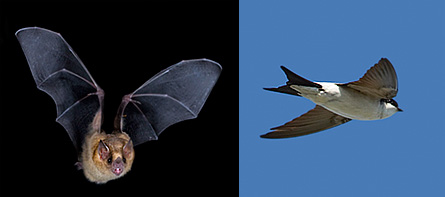Birds, bats leave different wakes
Analysis of wind-tunnel data provides details about the creatures’ aerodynamics
The aerodynamic wake left behind a bird in flight is fundamentally different from the atmospheric disturbance produced by a bat, new lab tests suggest. In large part, the disparity stems from the flapping techniques the creatures use as they power their way through the air.

Birds and bats evolved self-powered flight independently, says Anders Hedenström, a biomechanicist at Lund University in Sweden. How is still a mystery: Paleontologists haven’t yet discovered the transitional fossils that represent protobats (SN: 5/14/05, p. 314), and scientists continue to argue about whether birds conquered the air by swooping down from trees or flapping up from the ground (SN: 8/18/01, p. 106). Regardless of how those first fliers slipped the surly bonds of Earth, tests conducted in wind tunnels — similar to those used to evaluate the aerodynamic performance of scale-model aircraft — can shed light on the flight capabilities of modern birds and bats, says Hedenström.
He and his colleagues studied the vortices that flapping wings produced behind three species of European bird — the European robin, the thrush nightingale and the house martin — and Glossophaga soricina, a five-centimeter–long nectar-feeding bat that lives in Mexico and in Central and South America. By measuring how the air swirls at various spots in the wind tunnel about 15 to 20 body lengths behind each creature, the researchers could estimate the thrust and lift the birds and bats generated, the researchers report in an upcoming Journal of the Royal Society Interface.
While birds typically generated a vortex that was consistently strong across its width, the bats produced a split vortex, with a strong swirl of air spilling from each wing but very little circulation in the area directly behind the body. Subsequent tests with a larger species of bat — data that is yet to be published, Hedenström notes — show the same split vortex. Using two vortices to generate lift and thrust is less energy efficient than using one.
The team notes that birds and bats may flap differently because of their wing and overall body structure. While bats have relatively blunt faces and ears that cause atmospheric drag, birds are streamlined and have to expend less energy to power their way forward. The difference between the groups in flight efficiency may help explain why one of the world’s largest flight-capable birds, the California condor, is about 10 times the size of the largest bat, Hedenström says.
Wind tunnel data also reveal that a flapping bird’s vortex varies through time, starting off small and increasing during each downstroke of the wing. Bats, on the other hand, generate a vortex from each wing that starts off strong and remains that way throughout the downstroke — possibly a way to partially counteract the inefficiency of producing two vortices, Hedenström says.
The new findings are an intriguing analysis of hard-to-gather data, says Kenny Breuer, a fluid dynamicist at Brown University in Providence, R.I. But he says it may be too early to make broad statements about bat flight because the published report looks at only one species of bat, and the bats are flying at low speeds, almost hovering. “Bats come in many shapes and sizes,” Breuer says, “and there’s a big difference between flying slow and flying fast.” Nevertheless, he adds, the tests “are a really great place to start, they open the door for comparative analyses of other species.”